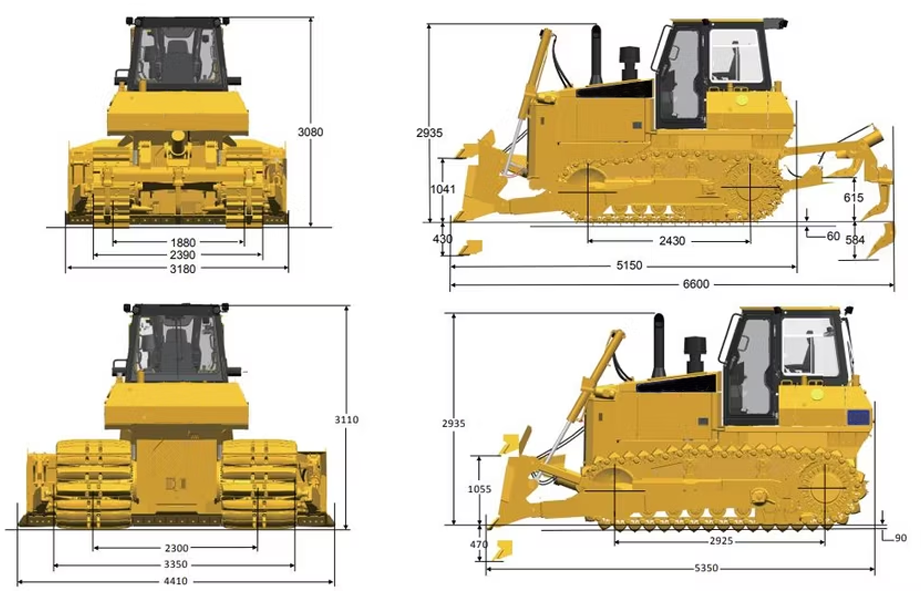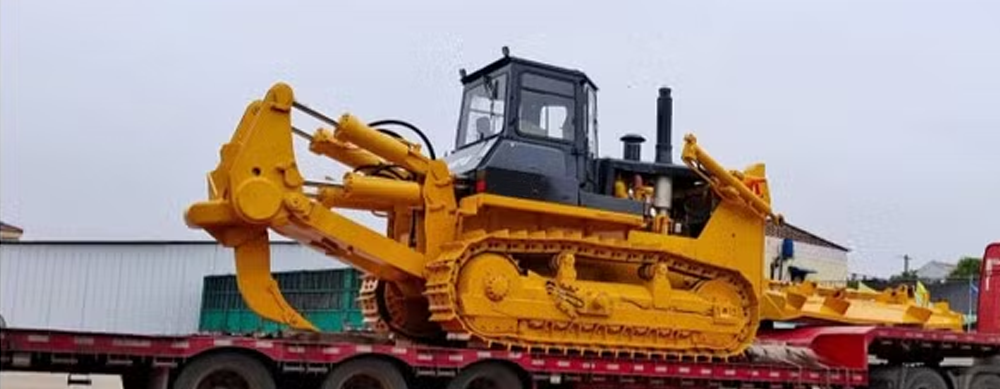Wetland bulldozers are specialized heavy machinery designed for wetland environments. They feature wide, low-pressure tracks that minimize ground disturbance and prevent sinking in soft, marshy terrains. The front-mounted blade is engineered to cut through vegetation and move soil or sediment gently. These bulldozers are typically powered by engines optimized for reliable operation in humid conditions. The operator's cab is sealed and equipped with proper ventilation to keep the interior dry and comfortable. With enhanced stability and precise control, wetland bulldozers play a crucial role in wetland restoration, drainage projects, and construction work where waterlogged areas are involved.
| Pictures |
|
|
|
|
|
| General parameters | |||||
| Model | SEM818D | 818F | 818F | SEM822D | 824F |
| Type | Wetland type | Wetland type | Wetland type | Wetland type | Wetland type |
| Operating weight (kg) | 19780 | 19550 | 19060 | 27880 | 27580 |
| Climbing capacity (°) | 30 | 30 | 30 | 30 | 30 |
| Ground Specific Pressure (kPa) | 24 | 30 | 38 | ||
| Power range | 120-220kW | 120-220kW | 120-220kW | 120-220kW | 120-220kW |
| Power Type | Fuel | Fuel | Fuel | Fuel | Fuel |
| Engine | |||||
| Model | WP7G200E472 | WP7G200E472 | WP10HG270E471 | ||
| Flywheel power (kW) | 140 | 147 | 147 | 183 | 211 |
| Rated speed (r/min) | 2200 | 2200 | 2200 | ||
| Emission standard | Euro 4 | Euro 4 | Euro 4 | ||
| Dimension | |||||
| Overall length (mm) | 5655 | ||||
| Overall width (mm) | 4230 | ||||
| Overall height (mm) | 3050 | ||||
| Track plate width (mm) | 950 | 1100 | 950 | 915 | 915 |
| Track Ground Length (mm) | 3225 | 3025 | 3488 | ||
| Minimum Turning Radius (mm) | 3920 | 3870 | 4300 | ||
| Minimum Ground Clearance (mm) | 400 | 400 | 400 | ||
| Transmission system | |||||
| Model | Dual, closed, electrically controlled hydrostatic transmission | Dual, closed, electrically controlled hydrostatic transmission | Dual, closed, electrically controlled hydrostatic transmission | ||
| Steering Brake | Wet Multi-Plate Brakes | Wet Multi-Plate Brakes | Wet Multi-Plate Brakes | ||
| Number of supporting wheels (single side) (pcs) | 7 | 7 | 7 | 8 | 8 |
| Number of sprockets (single side) (pcs) | 2 | 2 | 2 | 2 | 2 |
| Travel speed 1st gear (forward/reverse) (km/h) | 0~10 | 0~10 | 0~10 | ||
| Number of track plates | 44 | 42 | 45 | ||
| Shoveling device | |||||
| Model | Wetland Straight Tilt Shovel | Wetland Straight Tilt Shovel | Wetland Straight Tilt Shovel | Wetland Straight Tilt Shovel | Wetland Straight Tilt Shovel |
| Shovel capacity (m³) | 3.24 | 3.24 | 5.5 | ||
| Spade width | 4229 | 4229 | 4400 | ||
| Spade Height (mm) | 1000 | 1000 | 1350 | ||
| Maximum lifting height (mm) | 1055 | 1120 | 1165 | ||
| Maximum depth of cut (mm) | 480 | 510 | 665 | ||
| Maximum tilt (mm) | 367 | 397 | 640 |

1. Structure and Material: The chassis of a wetland bulldozer is typically constructed from high-strength steel. It has a sturdy design to withstand the various forces exerted during operation in soft and uneven wetland terrains.
2. Adaptation to Wetland Conditions: The frame often incorporates special features to suit wetland work.
3. Engine: Wetland bulldozers are equipped with engines that are specifically selected or modified for wetland operation. These engines usually have enhanced waterproofing and moisture-resistant features.
4. Transmission: The transmission system in a wetland bulldozer is responsible for transferring the engine's power to the tracks.
5. Tracks: The tracks of wetland bulldozers are wide and have a low ground pressure design. They are usually made of materials like special steel alloys or heavy-duty rubber with enhanced flexibility.
6. Underpinning Components: The undercarriage includes components like idler wheels, track rollers, carrier rollers, and sprockets. These parts work together to support the weight of the machine and ensure the smooth running of the tracks.
7. Hydraulic Pump: The hydraulic pump is the heart of the hydraulic system. It is usually driven by the engine and pressurizes the hydraulic fluid.
8. Hydraulic Cylinders: These cylinders convert the hydraulic pressure into mechanical force to move the blade and ripper.

1. Determine the volume and type of material you need to move. For wetland restoration projects that involve a lot of soil and vegetation, a bulldozer with a wide and deep blade is beneficial.
2. Assess the power needed to operate in the wetland environment. The engine's horsepower and the bulldozer's tractive effort are crucial factors.
3. For very soft and marshy terrains, a bulldozer with ultra-wide tracks and extremely low ground pressure is essential. The track design, such as the width and the pattern of the track shoes, should be optimized to prevent sinking.
4. In some wetlands, access can be limited due to narrow paths, dense vegetation, or proximity to other sensitive areas.
5. Select an engine that is well-suited for wet and humid conditions. Look for features such as water-resistant air intakes, efficient cooling systems, and good fuel efficiency.
6. The hydraulic system controls the movement of the blade and other attachments. A high-quality hydraulic system with a sufficient flow rate and pressure is necessary for smooth and precise blade adjustments.
7. The operator's cab should be comfortable and sealed to keep the interior dry and free from moisture. It should have an ergonomic seat that can be adjusted to reduce operator fatigue during long-working hours.

Wetland bulldozers are equipped with wide and specially designed tracks that significantly reduce ground pressure. This is a crucial feature as it allows the bulldozer to operate on soft, marshy wetland terrains without sinking.
The blade of a wetland bulldozer is engineered to handle the unique characteristics of wetland materials. It is usually designed to cut through vegetation and move wet soil and sediment with ease.
These bulldozers have components that are protected against water damage and corrosion. The engine, transmission, and other vital parts are sealed or have special coatings to prevent water ingress.
With a well-designed chassis and undercarriage, wetland bulldozers offer excellent stability. The low-center-of-gravity design, combined with the wide-track configuration, allows the machine to maintain balance even on uneven and slippery wetland surfaces.
The operator's cab is designed to provide a comfortable and functional workspace in the wetland environment. It is usually sealed to keep the interior dry and has good climate-control systems to combat humidity.
